Analysis of ASEAN Trade Policies and Challenges
VerifiedAdded on 2023/01/16
|11
|2495
|74
AI Summary
This report analyzes the trade policies of ASEAN, including tariffs, quotas, subsidies, and foreign direct investment. It also discusses the challenges faced in implementing these policies and provides recommendations for improvement.
Contribute Materials
Your contribution can guide someone’s learning journey. Share your
documents today.
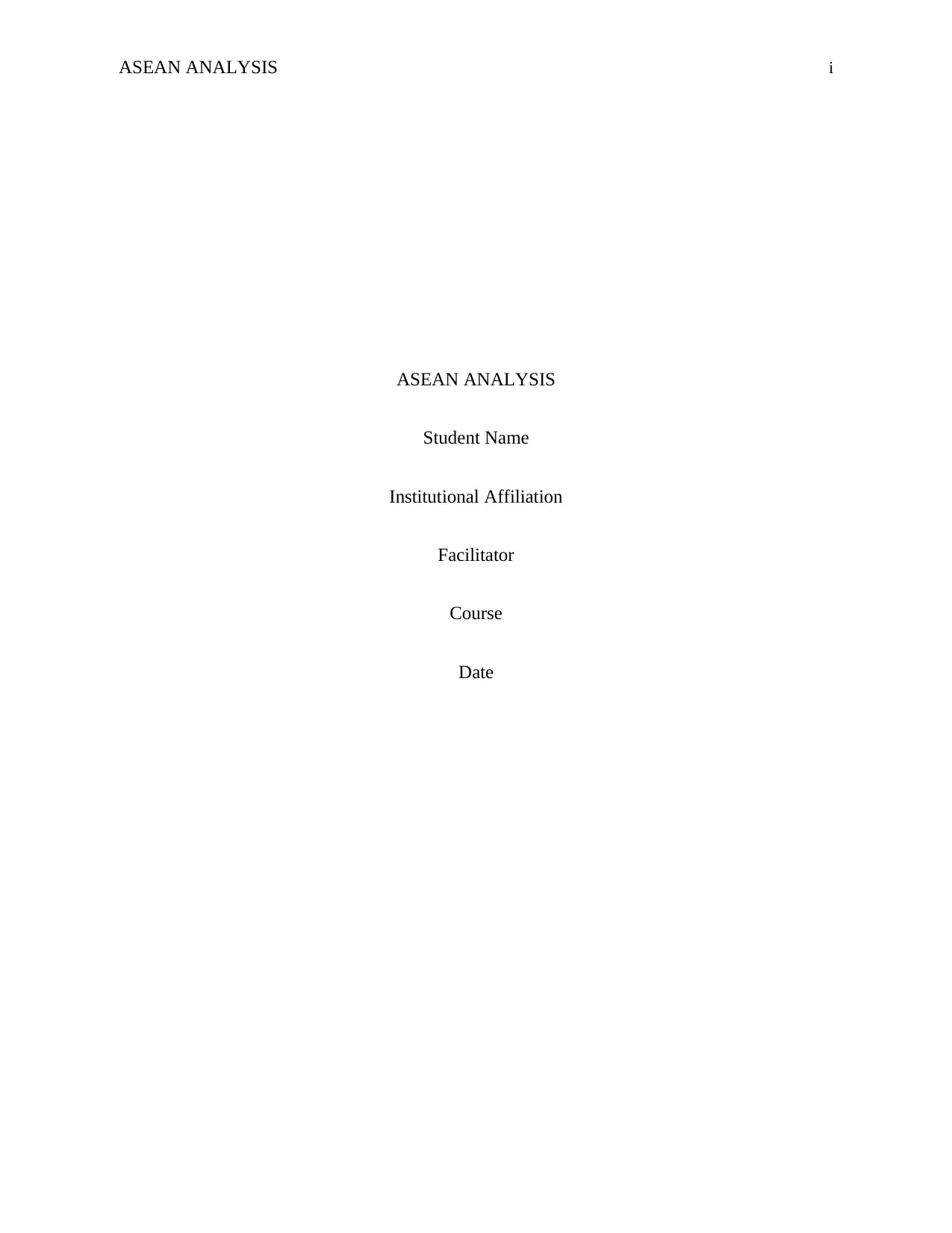
ASEAN ANALYSIS i
ASEAN ANALYSIS
Student Name
Institutional Affiliation
Facilitator
Course
Date
ASEAN ANALYSIS
Student Name
Institutional Affiliation
Facilitator
Course
Date
Secure Best Marks with AI Grader
Need help grading? Try our AI Grader for instant feedback on your assignments.
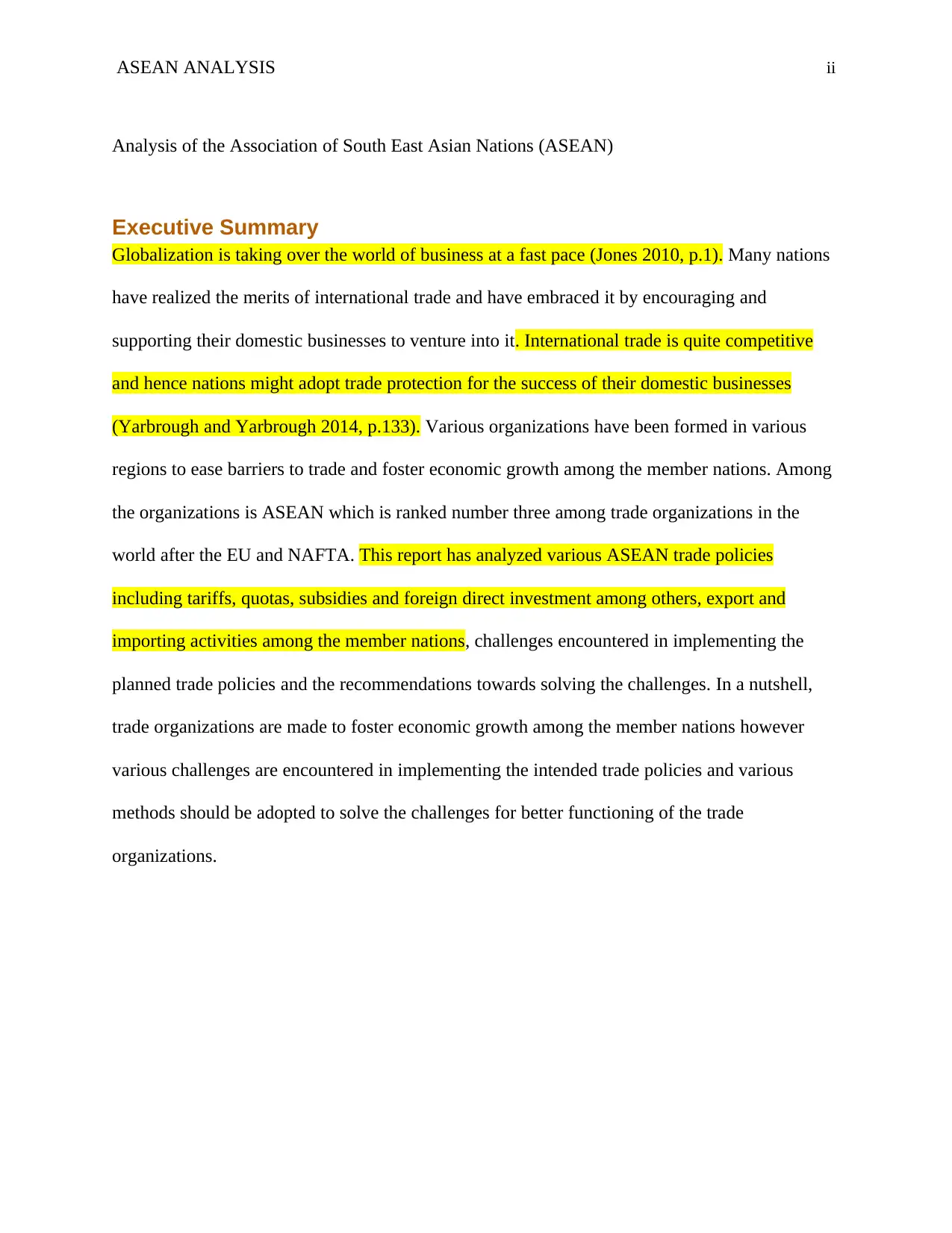
ASEAN ANALYSIS ii
Analysis of the Association of South East Asian Nations (ASEAN)
Executive Summary
Globalization is taking over the world of business at a fast pace (Jones 2010, p.1). Many nations
have realized the merits of international trade and have embraced it by encouraging and
supporting their domestic businesses to venture into it. International trade is quite competitive
and hence nations might adopt trade protection for the success of their domestic businesses
(Yarbrough and Yarbrough 2014, p.133). Various organizations have been formed in various
regions to ease barriers to trade and foster economic growth among the member nations. Among
the organizations is ASEAN which is ranked number three among trade organizations in the
world after the EU and NAFTA. This report has analyzed various ASEAN trade policies
including tariffs, quotas, subsidies and foreign direct investment among others, export and
importing activities among the member nations, challenges encountered in implementing the
planned trade policies and the recommendations towards solving the challenges. In a nutshell,
trade organizations are made to foster economic growth among the member nations however
various challenges are encountered in implementing the intended trade policies and various
methods should be adopted to solve the challenges for better functioning of the trade
organizations.
Analysis of the Association of South East Asian Nations (ASEAN)
Executive Summary
Globalization is taking over the world of business at a fast pace (Jones 2010, p.1). Many nations
have realized the merits of international trade and have embraced it by encouraging and
supporting their domestic businesses to venture into it. International trade is quite competitive
and hence nations might adopt trade protection for the success of their domestic businesses
(Yarbrough and Yarbrough 2014, p.133). Various organizations have been formed in various
regions to ease barriers to trade and foster economic growth among the member nations. Among
the organizations is ASEAN which is ranked number three among trade organizations in the
world after the EU and NAFTA. This report has analyzed various ASEAN trade policies
including tariffs, quotas, subsidies and foreign direct investment among others, export and
importing activities among the member nations, challenges encountered in implementing the
planned trade policies and the recommendations towards solving the challenges. In a nutshell,
trade organizations are made to foster economic growth among the member nations however
various challenges are encountered in implementing the intended trade policies and various
methods should be adopted to solve the challenges for better functioning of the trade
organizations.
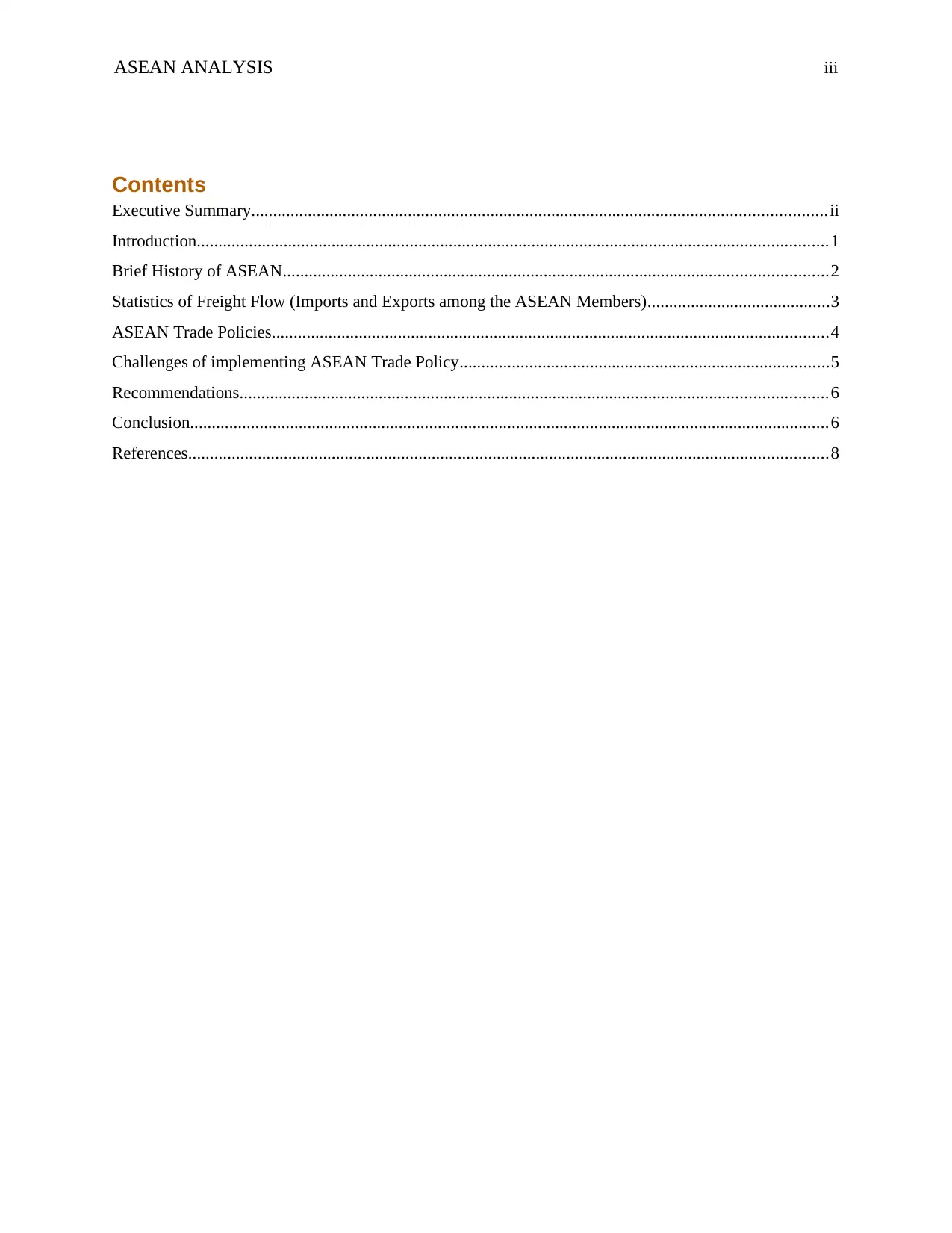
ASEAN ANALYSIS iii
Contents
Executive Summary....................................................................................................................................ii
Introduction.................................................................................................................................................1
Brief History of ASEAN.............................................................................................................................2
Statistics of Freight Flow (Imports and Exports among the ASEAN Members)..........................................3
ASEAN Trade Policies................................................................................................................................4
Challenges of implementing ASEAN Trade Policy.....................................................................................5
Recommendations.......................................................................................................................................6
Conclusion...................................................................................................................................................6
References...................................................................................................................................................8
Contents
Executive Summary....................................................................................................................................ii
Introduction.................................................................................................................................................1
Brief History of ASEAN.............................................................................................................................2
Statistics of Freight Flow (Imports and Exports among the ASEAN Members)..........................................3
ASEAN Trade Policies................................................................................................................................4
Challenges of implementing ASEAN Trade Policy.....................................................................................5
Recommendations.......................................................................................................................................6
Conclusion...................................................................................................................................................6
References...................................................................................................................................................8

ASEAN ANALYSIS 1
Introduction
Today’s world of business has become more globalized. Due to the realization of various merits
associated with international trade, nations have encouraged and supported their domestic
businesses to venture into it (Steger 2017, p.86). International trade is quite competitive and
hence requires sound adoption of micro and macroeconomic policies by various players in order
to succeed (Edmond, Midrigan and Xu 2015, p.3183). Due to stiff competition in international
trade, nations may engage in trade protectionism to protect their domestic players from foreign
competition as they may be outdone both in the international and domestic market by foreign
competitors. Protectionism has negative impacts on an economy as it results in inefficiency in
production which leads to the production of expensive low-quality goods and services to the
nation’s consumers. Therefore, it would be advisable for nations to avoid protectionism if
possible for better economic growth as their industries have to play it smart to survive foreign
competition.
Various nations from certain regions have formed free trade organizations to foster economic
growth for their nations. Trade organizations establish viable trading policies among their
members to reap maximum benefits from their trading activities. They also establish external
relations with other nations on behalf of their nations to extend trading activities to third-party
nations. All these activities try to reach the major goal of forming an organization by nations
which is an improvement of economic growth among member countries. In this report, a
discussion of the Association of South East Asian Nations (ASEAN) has been done. Its various
trade policies and challenges in their implementation, as well as recommendations, have been
discussed. In a nutshell, trade organizations or rather agreements among various nations are
Introduction
Today’s world of business has become more globalized. Due to the realization of various merits
associated with international trade, nations have encouraged and supported their domestic
businesses to venture into it (Steger 2017, p.86). International trade is quite competitive and
hence requires sound adoption of micro and macroeconomic policies by various players in order
to succeed (Edmond, Midrigan and Xu 2015, p.3183). Due to stiff competition in international
trade, nations may engage in trade protectionism to protect their domestic players from foreign
competition as they may be outdone both in the international and domestic market by foreign
competitors. Protectionism has negative impacts on an economy as it results in inefficiency in
production which leads to the production of expensive low-quality goods and services to the
nation’s consumers. Therefore, it would be advisable for nations to avoid protectionism if
possible for better economic growth as their industries have to play it smart to survive foreign
competition.
Various nations from certain regions have formed free trade organizations to foster economic
growth for their nations. Trade organizations establish viable trading policies among their
members to reap maximum benefits from their trading activities. They also establish external
relations with other nations on behalf of their nations to extend trading activities to third-party
nations. All these activities try to reach the major goal of forming an organization by nations
which is an improvement of economic growth among member countries. In this report, a
discussion of the Association of South East Asian Nations (ASEAN) has been done. Its various
trade policies and challenges in their implementation, as well as recommendations, have been
discussed. In a nutshell, trade organizations or rather agreements among various nations are
Paraphrase This Document
Need a fresh take? Get an instant paraphrase of this document with our AI Paraphraser
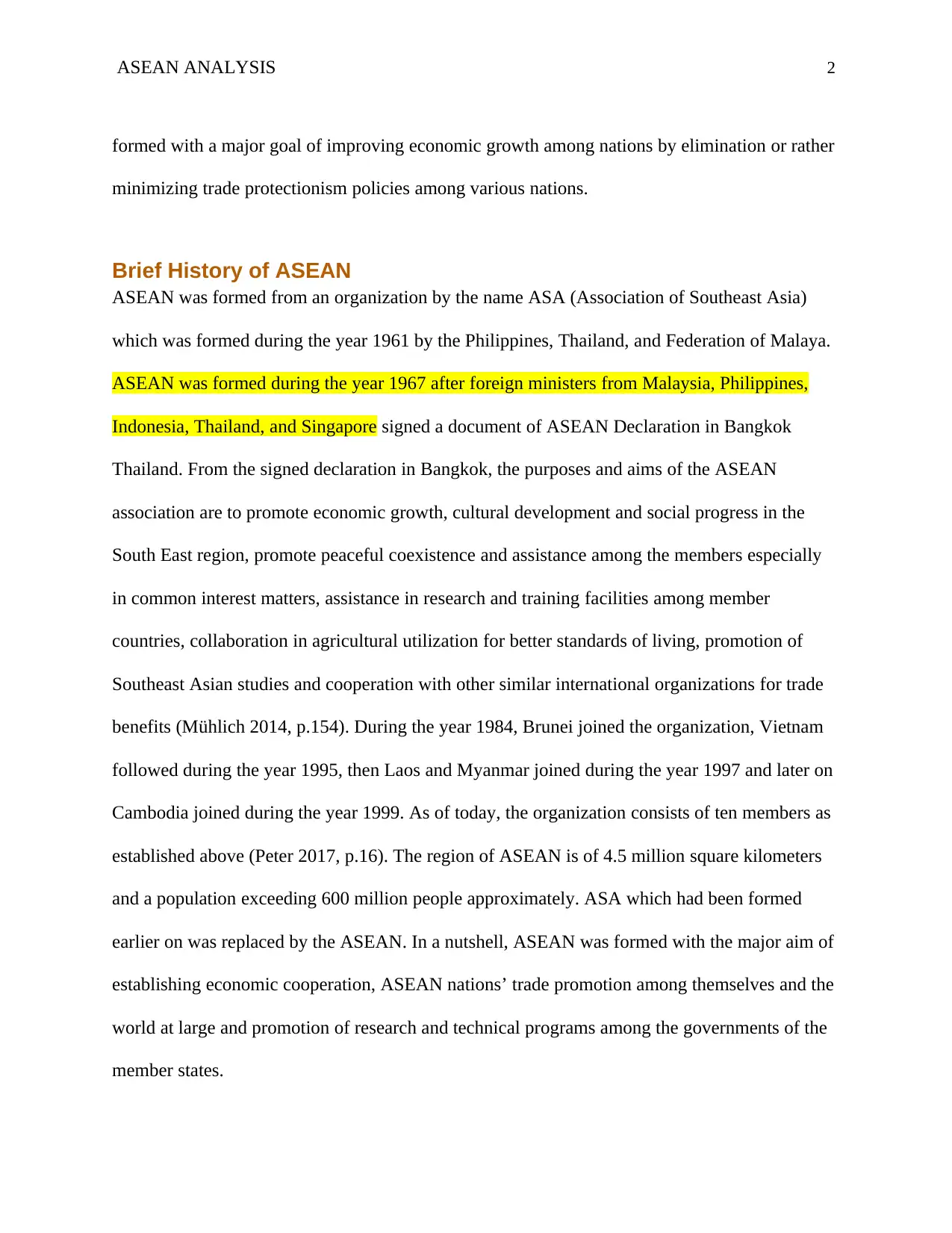
ASEAN ANALYSIS 2
formed with a major goal of improving economic growth among nations by elimination or rather
minimizing trade protectionism policies among various nations.
Brief History of ASEAN
ASEAN was formed from an organization by the name ASA (Association of Southeast Asia)
which was formed during the year 1961 by the Philippines, Thailand, and Federation of Malaya.
ASEAN was formed during the year 1967 after foreign ministers from Malaysia, Philippines,
Indonesia, Thailand, and Singapore signed a document of ASEAN Declaration in Bangkok
Thailand. From the signed declaration in Bangkok, the purposes and aims of the ASEAN
association are to promote economic growth, cultural development and social progress in the
South East region, promote peaceful coexistence and assistance among the members especially
in common interest matters, assistance in research and training facilities among member
countries, collaboration in agricultural utilization for better standards of living, promotion of
Southeast Asian studies and cooperation with other similar international organizations for trade
benefits (Mühlich 2014, p.154). During the year 1984, Brunei joined the organization, Vietnam
followed during the year 1995, then Laos and Myanmar joined during the year 1997 and later on
Cambodia joined during the year 1999. As of today, the organization consists of ten members as
established above (Peter 2017, p.16). The region of ASEAN is of 4.5 million square kilometers
and a population exceeding 600 million people approximately. ASA which had been formed
earlier on was replaced by the ASEAN. In a nutshell, ASEAN was formed with the major aim of
establishing economic cooperation, ASEAN nations’ trade promotion among themselves and the
world at large and promotion of research and technical programs among the governments of the
member states.
formed with a major goal of improving economic growth among nations by elimination or rather
minimizing trade protectionism policies among various nations.
Brief History of ASEAN
ASEAN was formed from an organization by the name ASA (Association of Southeast Asia)
which was formed during the year 1961 by the Philippines, Thailand, and Federation of Malaya.
ASEAN was formed during the year 1967 after foreign ministers from Malaysia, Philippines,
Indonesia, Thailand, and Singapore signed a document of ASEAN Declaration in Bangkok
Thailand. From the signed declaration in Bangkok, the purposes and aims of the ASEAN
association are to promote economic growth, cultural development and social progress in the
South East region, promote peaceful coexistence and assistance among the members especially
in common interest matters, assistance in research and training facilities among member
countries, collaboration in agricultural utilization for better standards of living, promotion of
Southeast Asian studies and cooperation with other similar international organizations for trade
benefits (Mühlich 2014, p.154). During the year 1984, Brunei joined the organization, Vietnam
followed during the year 1995, then Laos and Myanmar joined during the year 1997 and later on
Cambodia joined during the year 1999. As of today, the organization consists of ten members as
established above (Peter 2017, p.16). The region of ASEAN is of 4.5 million square kilometers
and a population exceeding 600 million people approximately. ASA which had been formed
earlier on was replaced by the ASEAN. In a nutshell, ASEAN was formed with the major aim of
establishing economic cooperation, ASEAN nations’ trade promotion among themselves and the
world at large and promotion of research and technical programs among the governments of the
member states.
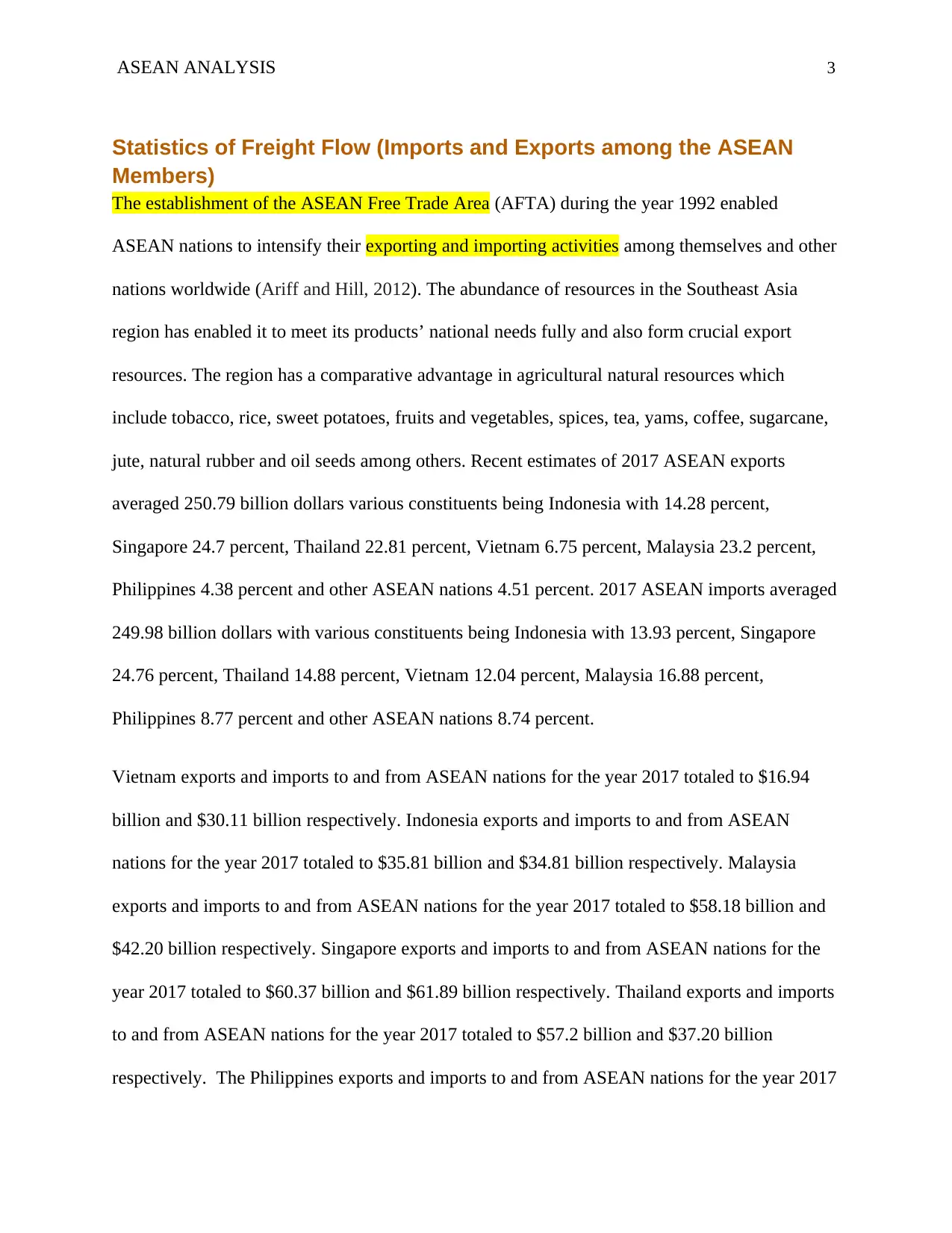
ASEAN ANALYSIS 3
Statistics of Freight Flow (Imports and Exports among the ASEAN
Members)
The establishment of the ASEAN Free Trade Area (AFTA) during the year 1992 enabled
ASEAN nations to intensify their exporting and importing activities among themselves and other
nations worldwide (Ariff and Hill, 2012). The abundance of resources in the Southeast Asia
region has enabled it to meet its products’ national needs fully and also form crucial export
resources. The region has a comparative advantage in agricultural natural resources which
include tobacco, rice, sweet potatoes, fruits and vegetables, spices, tea, yams, coffee, sugarcane,
jute, natural rubber and oil seeds among others. Recent estimates of 2017 ASEAN exports
averaged 250.79 billion dollars various constituents being Indonesia with 14.28 percent,
Singapore 24.7 percent, Thailand 22.81 percent, Vietnam 6.75 percent, Malaysia 23.2 percent,
Philippines 4.38 percent and other ASEAN nations 4.51 percent. 2017 ASEAN imports averaged
249.98 billion dollars with various constituents being Indonesia with 13.93 percent, Singapore
24.76 percent, Thailand 14.88 percent, Vietnam 12.04 percent, Malaysia 16.88 percent,
Philippines 8.77 percent and other ASEAN nations 8.74 percent.
Vietnam exports and imports to and from ASEAN nations for the year 2017 totaled to $16.94
billion and $30.11 billion respectively. Indonesia exports and imports to and from ASEAN
nations for the year 2017 totaled to $35.81 billion and $34.81 billion respectively. Malaysia
exports and imports to and from ASEAN nations for the year 2017 totaled to $58.18 billion and
$42.20 billion respectively. Singapore exports and imports to and from ASEAN nations for the
year 2017 totaled to $60.37 billion and $61.89 billion respectively. Thailand exports and imports
to and from ASEAN nations for the year 2017 totaled to $57.2 billion and $37.20 billion
respectively. The Philippines exports and imports to and from ASEAN nations for the year 2017
Statistics of Freight Flow (Imports and Exports among the ASEAN
Members)
The establishment of the ASEAN Free Trade Area (AFTA) during the year 1992 enabled
ASEAN nations to intensify their exporting and importing activities among themselves and other
nations worldwide (Ariff and Hill, 2012). The abundance of resources in the Southeast Asia
region has enabled it to meet its products’ national needs fully and also form crucial export
resources. The region has a comparative advantage in agricultural natural resources which
include tobacco, rice, sweet potatoes, fruits and vegetables, spices, tea, yams, coffee, sugarcane,
jute, natural rubber and oil seeds among others. Recent estimates of 2017 ASEAN exports
averaged 250.79 billion dollars various constituents being Indonesia with 14.28 percent,
Singapore 24.7 percent, Thailand 22.81 percent, Vietnam 6.75 percent, Malaysia 23.2 percent,
Philippines 4.38 percent and other ASEAN nations 4.51 percent. 2017 ASEAN imports averaged
249.98 billion dollars with various constituents being Indonesia with 13.93 percent, Singapore
24.76 percent, Thailand 14.88 percent, Vietnam 12.04 percent, Malaysia 16.88 percent,
Philippines 8.77 percent and other ASEAN nations 8.74 percent.
Vietnam exports and imports to and from ASEAN nations for the year 2017 totaled to $16.94
billion and $30.11 billion respectively. Indonesia exports and imports to and from ASEAN
nations for the year 2017 totaled to $35.81 billion and $34.81 billion respectively. Malaysia
exports and imports to and from ASEAN nations for the year 2017 totaled to $58.18 billion and
$42.20 billion respectively. Singapore exports and imports to and from ASEAN nations for the
year 2017 totaled to $60.37 billion and $61.89 billion respectively. Thailand exports and imports
to and from ASEAN nations for the year 2017 totaled to $57.2 billion and $37.20 billion
respectively. The Philippines exports and imports to and from ASEAN nations for the year 2017

ASEAN ANALYSIS 4
totaled to $10.99 billion and $21.92 billion respectively. Brunei exports and imports to and from
ASEAN nations for the year 2017 totaled to $0.896 billion and $1.423 billion respectively. Laos
exports and imports to and from ASEAN nations for the year 2017 totaled to $2.4 billion and
$4.58 billion respectively. Cambodia exports and imports to and from ASEAN nations for the
year 2017 totaled to $2.75 billion and $7.05 billion respectively. Myanmar exports and imports
to and from ASEAN nations for the year 2017 totaled to $5.26 billion and $8.80 billion
respectively.
ASEAN Trade Policies
The establishment of AFTA during the year 1992 led to low tariffs among the ASEAN members
through the Common Effective Preferential Tariff (CEPT) Scheme. Tariffs for six member
nations namely the Philippines, Brunei, Thailand, Singapore, Indonesia, and Malaysia have been
lowered to 0 to 5 percent range since the establishment of AFTA. The late members of the
ASEAN (Vietnam, Laos, Cambodia, and Myanmar) have not yet adopted this policy fully but
they have most of their products (actually more than 80 percent) listed in the list of CEPT-AFTA
which have 5 or less percentage of tariffs. Some highly sensitive products such as rice and other
products in the General Exception List are not subjected to the tariffs agreement. Some nations
like Indonesia have 25 percent rice tariffs while the Philippines has 35 percent tariffs on rice.
Although tariffs have been greatly reduced among the ASEAN nations, non-tariff measures
continue to increase. For instance, non-tariff measures increased from 1634 to 5975 from the
year 2000 to 2015 among the ASEAN nations. Non-tariff measures have been noticed in various
ASEAN nations namely the Philippines, Singapore, Vietnam, Thailand, Laos, and Cambodia
whereby these measures have been applying on all their products. The highest percentages of
totaled to $10.99 billion and $21.92 billion respectively. Brunei exports and imports to and from
ASEAN nations for the year 2017 totaled to $0.896 billion and $1.423 billion respectively. Laos
exports and imports to and from ASEAN nations for the year 2017 totaled to $2.4 billion and
$4.58 billion respectively. Cambodia exports and imports to and from ASEAN nations for the
year 2017 totaled to $2.75 billion and $7.05 billion respectively. Myanmar exports and imports
to and from ASEAN nations for the year 2017 totaled to $5.26 billion and $8.80 billion
respectively.
ASEAN Trade Policies
The establishment of AFTA during the year 1992 led to low tariffs among the ASEAN members
through the Common Effective Preferential Tariff (CEPT) Scheme. Tariffs for six member
nations namely the Philippines, Brunei, Thailand, Singapore, Indonesia, and Malaysia have been
lowered to 0 to 5 percent range since the establishment of AFTA. The late members of the
ASEAN (Vietnam, Laos, Cambodia, and Myanmar) have not yet adopted this policy fully but
they have most of their products (actually more than 80 percent) listed in the list of CEPT-AFTA
which have 5 or less percentage of tariffs. Some highly sensitive products such as rice and other
products in the General Exception List are not subjected to the tariffs agreement. Some nations
like Indonesia have 25 percent rice tariffs while the Philippines has 35 percent tariffs on rice.
Although tariffs have been greatly reduced among the ASEAN nations, non-tariff measures
continue to increase. For instance, non-tariff measures increased from 1634 to 5975 from the
year 2000 to 2015 among the ASEAN nations. Non-tariff measures have been noticed in various
ASEAN nations namely the Philippines, Singapore, Vietnam, Thailand, Laos, and Cambodia
whereby these measures have been applying on all their products. The highest percentages of
Secure Best Marks with AI Grader
Need help grading? Try our AI Grader for instant feedback on your assignments.

ASEAN ANALYSIS 5
non-tariff measures have been observed in Sanitary and Phytosanitary Measures and Technical
Barriers to Trade with percentages of 33.2 and 43.1 respectively of the total noted non-tariff
measures noted up to 2015. Quotas and other Contingent protective measures account for 1.9
percent with subsidies accounting for almost zero percent. This shows that quotas and subsidies
do not have a significant effect on trade among the ASEAN nations.
The ASEAN nations have intensified cooperation among them and have strengthened their
competitiveness in digitalizing their economies. As a result, foreign direct investment to the
ASEAN nations has been increasing especially in the digital economy sectors which include
venture capital, e-commerce, and fin-tech among others (Montes 2017, p.176). FDI in ASEAN
nations increased from $123 billion to $137 billion from the year 2016 to 2017 and more
investments are anticipated in the future.
Challenges of implementing ASEAN Trade Policy
Lack of central mechanism among the ASEAN nations to enforce compliance: ASEAN nations
do not fully comply with the set policies and there is no central body to look into this. For
instance, only 30 percent of ASEAN trade policies have been implemented which could
otherwise be improved if an enforcement body was formed (Anon, 2015).
Lack of proper knowledge about the ASEAN among its members: ASEAN members lack in-
depth knowledge about each other and hence this acts as a barrier in implementing trade policies
among trading partners who lack detailed information about each other.
Inequality in income levels among the ASEAN nations: Some ASEAN nations are better placed
in terms of economic development while others lag behind (Chia 2011, p.43). This, therefore,
non-tariff measures have been observed in Sanitary and Phytosanitary Measures and Technical
Barriers to Trade with percentages of 33.2 and 43.1 respectively of the total noted non-tariff
measures noted up to 2015. Quotas and other Contingent protective measures account for 1.9
percent with subsidies accounting for almost zero percent. This shows that quotas and subsidies
do not have a significant effect on trade among the ASEAN nations.
The ASEAN nations have intensified cooperation among them and have strengthened their
competitiveness in digitalizing their economies. As a result, foreign direct investment to the
ASEAN nations has been increasing especially in the digital economy sectors which include
venture capital, e-commerce, and fin-tech among others (Montes 2017, p.176). FDI in ASEAN
nations increased from $123 billion to $137 billion from the year 2016 to 2017 and more
investments are anticipated in the future.
Challenges of implementing ASEAN Trade Policy
Lack of central mechanism among the ASEAN nations to enforce compliance: ASEAN nations
do not fully comply with the set policies and there is no central body to look into this. For
instance, only 30 percent of ASEAN trade policies have been implemented which could
otherwise be improved if an enforcement body was formed (Anon, 2015).
Lack of proper knowledge about the ASEAN among its members: ASEAN members lack in-
depth knowledge about each other and hence this acts as a barrier in implementing trade policies
among trading partners who lack detailed information about each other.
Inequality in income levels among the ASEAN nations: Some ASEAN nations are better placed
in terms of economic development while others lag behind (Chia 2011, p.43). This, therefore,

ASEAN ANALYSIS 6
brings about a disparity in income distribution among the nations with the better-placed nations
having consumers who have higher purchasing power than those from undeveloped nations.
Therefore, it becomes difficult in implementing policies for nations which have a greater range
in terms of economic development.
Recommendations
A central authority should be formed among the ASEAN nations to oversee the implementation
of the planned trade policies among all the members.
The ASEAN planned trade policies should be implemented proportionately among the different
members according to their levels of economic growth due to a disparity in income distribution.
ASEAN issues should be taught thoroughly among the ASEAN members education system to
create awareness about the association. This will ease implementation as citizens from ASEAN
nations know what it entails and even support decision making just like in the European Union.
Conclusion
Today’s world of business has become highly globalized and various nations have embraced
international trade to enjoy its various merits. International trade is associated with stiff
competition and the nation might undertake trade protectionism to protect their domestic
businesses and enable them to succeed. Due to this, various trade organizations have been
formed to ease barriers to trade among various nations and foster economic growth among these
nations. One of the formed organizations is ASEAN which is among the largest trade
organizations in the world having been ranked position three after the EU and the NAFTA.
ASEAN has been trying its best to establish economic prosperity among its members through
brings about a disparity in income distribution among the nations with the better-placed nations
having consumers who have higher purchasing power than those from undeveloped nations.
Therefore, it becomes difficult in implementing policies for nations which have a greater range
in terms of economic development.
Recommendations
A central authority should be formed among the ASEAN nations to oversee the implementation
of the planned trade policies among all the members.
The ASEAN planned trade policies should be implemented proportionately among the different
members according to their levels of economic growth due to a disparity in income distribution.
ASEAN issues should be taught thoroughly among the ASEAN members education system to
create awareness about the association. This will ease implementation as citizens from ASEAN
nations know what it entails and even support decision making just like in the European Union.
Conclusion
Today’s world of business has become highly globalized and various nations have embraced
international trade to enjoy its various merits. International trade is associated with stiff
competition and the nation might undertake trade protectionism to protect their domestic
businesses and enable them to succeed. Due to this, various trade organizations have been
formed to ease barriers to trade among various nations and foster economic growth among these
nations. One of the formed organizations is ASEAN which is among the largest trade
organizations in the world having been ranked position three after the EU and the NAFTA.
ASEAN has been trying its best to establish economic prosperity among its members through
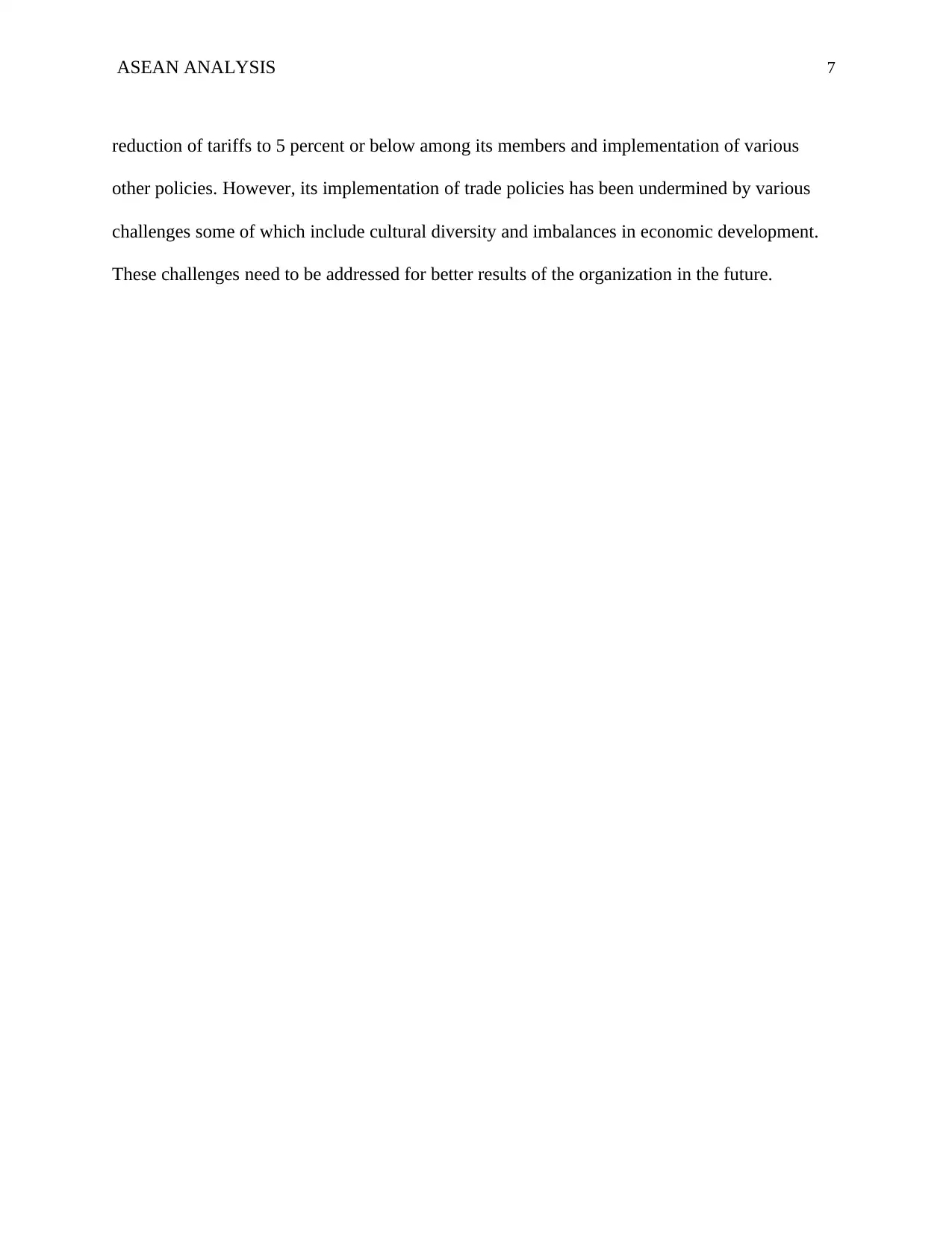
ASEAN ANALYSIS 7
reduction of tariffs to 5 percent or below among its members and implementation of various
other policies. However, its implementation of trade policies has been undermined by various
challenges some of which include cultural diversity and imbalances in economic development.
These challenges need to be addressed for better results of the organization in the future.
reduction of tariffs to 5 percent or below among its members and implementation of various
other policies. However, its implementation of trade policies has been undermined by various
challenges some of which include cultural diversity and imbalances in economic development.
These challenges need to be addressed for better results of the organization in the future.
Paraphrase This Document
Need a fresh take? Get an instant paraphrase of this document with our AI Paraphraser
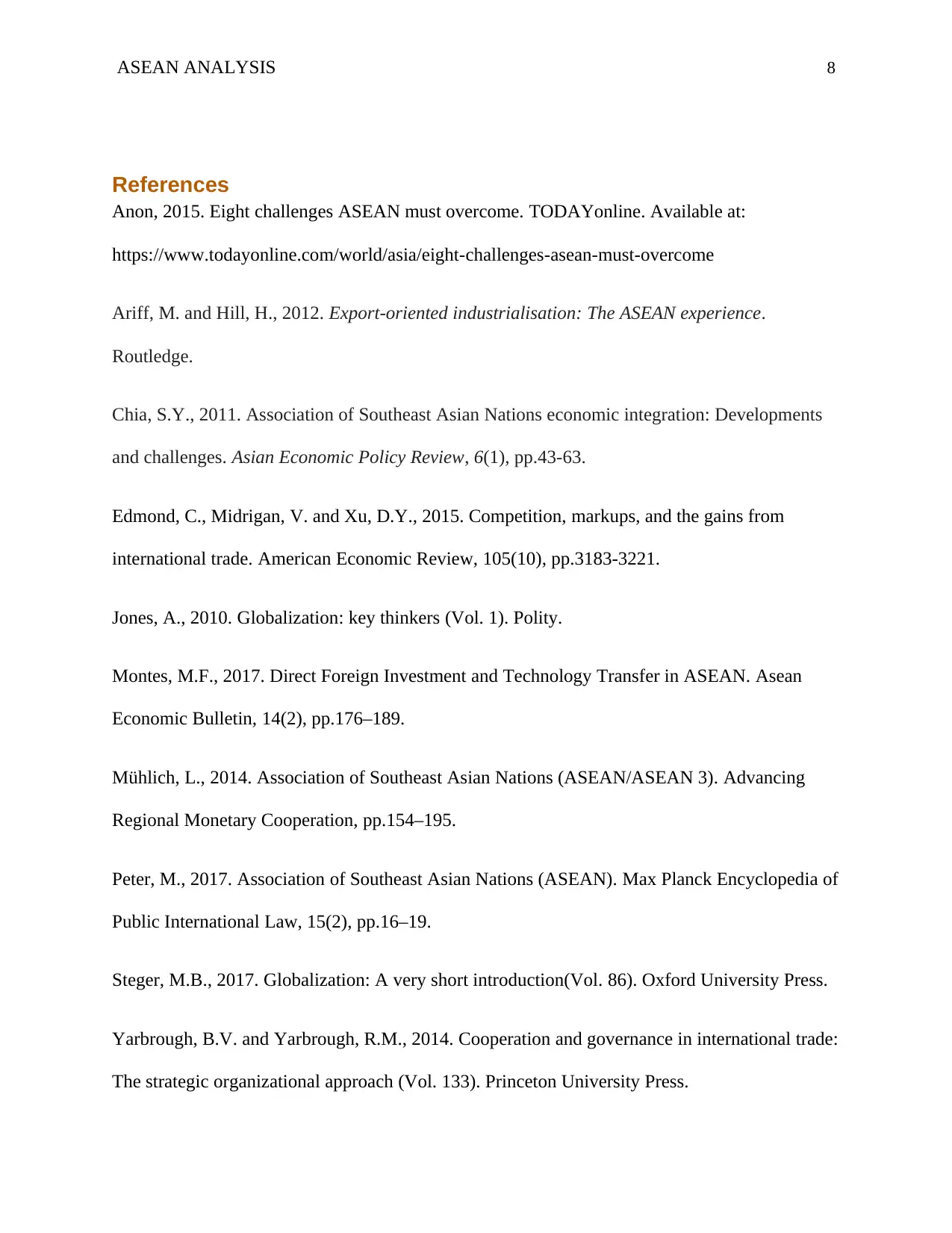
ASEAN ANALYSIS 8
References
Anon, 2015. Eight challenges ASEAN must overcome. TODAYonline. Available at:
https://www.todayonline.com/world/asia/eight-challenges-asean-must-overcome
Ariff, M. and Hill, H., 2012. Export-oriented industrialisation: The ASEAN experience.
Routledge.
Chia, S.Y., 2011. Association of Southeast Asian Nations economic integration: Developments
and challenges. Asian Economic Policy Review, 6(1), pp.43-63.
Edmond, C., Midrigan, V. and Xu, D.Y., 2015. Competition, markups, and the gains from
international trade. American Economic Review, 105(10), pp.3183-3221.
Jones, A., 2010. Globalization: key thinkers (Vol. 1). Polity.
Montes, M.F., 2017. Direct Foreign Investment and Technology Transfer in ASEAN. Asean
Economic Bulletin, 14(2), pp.176–189.
Mühlich, L., 2014. Association of Southeast Asian Nations (ASEAN/ASEAN 3). Advancing
Regional Monetary Cooperation, pp.154–195.
Peter, M., 2017. Association of Southeast Asian Nations (ASEAN). Max Planck Encyclopedia of
Public International Law, 15(2), pp.16–19.
Steger, M.B., 2017. Globalization: A very short introduction(Vol. 86). Oxford University Press.
Yarbrough, B.V. and Yarbrough, R.M., 2014. Cooperation and governance in international trade:
The strategic organizational approach (Vol. 133). Princeton University Press.
References
Anon, 2015. Eight challenges ASEAN must overcome. TODAYonline. Available at:
https://www.todayonline.com/world/asia/eight-challenges-asean-must-overcome
Ariff, M. and Hill, H., 2012. Export-oriented industrialisation: The ASEAN experience.
Routledge.
Chia, S.Y., 2011. Association of Southeast Asian Nations economic integration: Developments
and challenges. Asian Economic Policy Review, 6(1), pp.43-63.
Edmond, C., Midrigan, V. and Xu, D.Y., 2015. Competition, markups, and the gains from
international trade. American Economic Review, 105(10), pp.3183-3221.
Jones, A., 2010. Globalization: key thinkers (Vol. 1). Polity.
Montes, M.F., 2017. Direct Foreign Investment and Technology Transfer in ASEAN. Asean
Economic Bulletin, 14(2), pp.176–189.
Mühlich, L., 2014. Association of Southeast Asian Nations (ASEAN/ASEAN 3). Advancing
Regional Monetary Cooperation, pp.154–195.
Peter, M., 2017. Association of Southeast Asian Nations (ASEAN). Max Planck Encyclopedia of
Public International Law, 15(2), pp.16–19.
Steger, M.B., 2017. Globalization: A very short introduction(Vol. 86). Oxford University Press.
Yarbrough, B.V. and Yarbrough, R.M., 2014. Cooperation and governance in international trade:
The strategic organizational approach (Vol. 133). Princeton University Press.
1 out of 11
![[object Object]](/_next/static/media/star-bottom.7253800d.svg)





